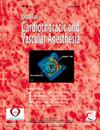在接受肺动脉重建和单焦点手术的小儿患者中使用丙胺的血液动力学效应:试验性研究:丙胺对儿童血流动力学的影响。
IF 2.3
4区 医学
Q2 ANESTHESIOLOGY
Journal of cardiothoracic and vascular anesthesia
Pub Date : 2025-01-01
DOI:10.1053/j.jvca.2024.11.001
引用次数: 0
摘要
目的确定使用质胺会增加接受单病灶或肺动脉重建手术患者的肺动脉压力(PAPs):设计:回顾性数据库研究:参与者: 所有接受肺动脉重建手术的患者:所有接受肺动脉重建或单灶手术的患者,均可在数据仓库中识别:我们从斯坦福大学的数据存储库中收集数据,将其格式化,并使用RStudio(v 2023.06.1+524)进行分析:我们的主要结果是使用质胺后 PAP 的变化。次要结果包括平均动脉压、肺动脉收缩压与全身动脉压的比值、右侧充盈压和左心房压的变化。在注射质胺后,我们发现 PAP 存在差异(Friedman χ2 = 49.46;P < 0.001)。与给药前 2 分钟相比,2 分钟(29.00 mmHg 对 25.00 mmHg;P<0.001)、5 分钟(30.00 mmHg 对 25.00 mmHg;P<0.001)和 10 分钟(31 mmHg 对 25 mmHg;P<0.001)时的 PAP 更高。与钙同时给药时,血压也显著升高(Friedman χ2 = 28.11;p < 0.001),给药后 10 分钟的血压高于给药前 2 分钟的血压(32 mmHg 对 26 mmHg;p < 0.001):结论:接受肺动脉重建或单灶手术的患者在脱离心肺旁路后,使用丙胺会导致血压略有升高。结论:肺动脉重建或单灶手术患者在脱离心肺旁路后服用质胺会导致血压小幅升高,而联合服用钙剂不会导致血压升高幅度增大。本文章由计算机程序翻译,如有差异,请以英文原文为准。
The Hemodynamic Effects of Protamine in Pediatric Patients Undergoing Pulmonary Artery Reconstruction and Unifocalization Surgery: A Pilot StudyHemodynamic Effects of Protamine in Children
Objectives
To determine protamine administration increases pulmonary artery pressures (PAPs) in patients undergoing unifocalization or pulmonary artery reconstruction surgeries.
Design
Retrospective database study.
Setting
A large pediatric heart center within an academic quaternary care facility.
Participants
All patients undergoing pulmonary artery reconstruction or a unifocalization procedure identifiable within the data warehouse.
Interventions
We collected data from Stanford University's data repository, formatted it, and analyzed it using RStudio (v 2023.06.1+524).
Measurements and Main Results
Our primary outcome is the change in PAP after the administration of protamine. Secondary outcomes include changes in the mean arterial pressure, the ratio of systolic pulmonary artery to systemic artery pressure, right-sided filling pressure, and left atrial pressure. After a protamine bolus, we found a difference in PAP (Friedman χ2 = 49.46; p < 0.001). When compared with 2 minutes before its administration, the PAP was higher at 2 minutes (29.00 mmHg versus 25.00 mmHg; p < 0.001), 5 minutes (30.00 mmHg versus 25.00 mmHg; p < 0.001) and 10 minutes (31 mmHg versus 25 mmHg; p < 0.001). When coadministered with calcium, there was also a significant increase in PAP (Friedman χ2 = 28.11; p < 0.001), with a higher PAP 10 minutes after calcium administration when compared with 2 minutes before (32 mmHg versus 26 mmHg; p < 0.001).
Conclusions
Protamine administration led to a small increase in PAP after separation from cardiopulmonary bypass in patients undergoing pulmonary artery reconstruction or unifocalization surgeries. Calcium coadministration did not lead to a greater increase in PAP.
求助全文
通过发布文献求助,成功后即可免费获取论文全文。
去求助
来源期刊
CiteScore
4.80
自引率
17.90%
发文量
606
审稿时长
37 days
期刊介绍:
The Journal of Cardiothoracic and Vascular Anesthesia is primarily aimed at anesthesiologists who deal with patients undergoing cardiac, thoracic or vascular surgical procedures. JCVA features a multidisciplinary approach, with contributions from cardiac, vascular and thoracic surgeons, cardiologists, and other related specialists. Emphasis is placed on rapid publication of clinically relevant material.

 求助内容:
求助内容: 应助结果提醒方式:
应助结果提醒方式:


